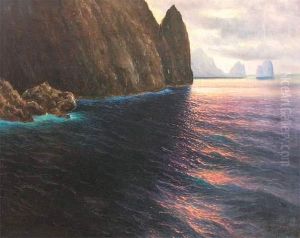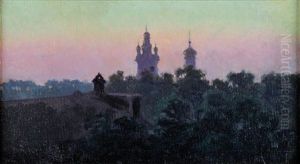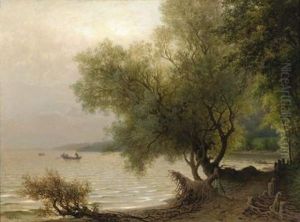Nikolai Nikonorovitch Doubovskoi Paintings
Nikolai Nikonorovitch Doubovskoi, often known as Nikolai Dubovskoy, was a Russian landscape painter associated with the Peredvizhniki movement, which aimed to break free from academic restrictions and make art more accessible to the general public. Born on December 17, 1859, in Novocherkassk, he showed an interest in the arts from an early age, which led him to pursue formal education in painting.
Doubovskoi attended the Imperial Academy of Arts in Saint Petersburg, where he studied under renowned painters such as Mikhail Konstantinovich Clodt and Volodymyr Orlovsky. His education provided him with a solid foundation in the academic tradition, but like many of his contemporaries in the Peredvizhniki, or 'Wanderers', he sought to depict real life and the Russian landscape with a more emotive and socially conscious approach.
Throughout his career, Doubovskoi became known for his atmospheric landscapes that often carried a sense of melancholy or foreboding. His paintings frequently featured expansive views, the grandeur of nature, and a subtle interplay of light and shadow, which helped to evoke emotional responses from the viewer. One of his most famous works, 'The Silence' (1890), is a prime example of his style and thematic focus. The painting depicts a vast, serene, and somewhat bleak landscape, highlighting the quiet and contemplative mood that was characteristic of his work.
Doubovskoi's contributions to Russian art were recognized during his lifetime, and he became a member of the Imperial Academy of Arts. He was also actively involved with the Peredvizhniki group, participating in their traveling exhibitions, which aimed at bringing art to people across the empire. Doubovskoi's commitment to art as a means of social commentary and emotional expression reflected the broader objectives of this movement.
Nikolai Dubovskoy's career was marked by his dedication to capturing the essence of Russia's natural environment and the moods it could inspire. Despite the political and social upheavals of his time, including the events leading up to the Russian Revolution of 1917, his work remained largely apolitical, focusing instead on the universal human experience of engaging with nature. Doubovskoi passed away on February 28, 1918, leaving behind a legacy of poignant landscapes that continue to resonate with audiences for their beauty and depth.


